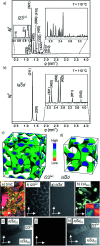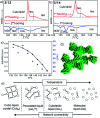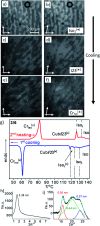Spontaneous mirror symmetry breaking in benzil-based soft crystalline, cubic liquid crystalline and isotropic liquid phases
- PMID: 32874512
- PMCID: PMC7446726
- DOI: 10.1039/d0sc01396j
Spontaneous mirror symmetry breaking in benzil-based soft crystalline, cubic liquid crystalline and isotropic liquid phases
Abstract
Benzil (diphenylethane-1,2-dione), which is a long known example for an achiral molecule crystallizing in a chiral space group, can also show mirror symmetry breaking in the fluid state if it is suitably functionalized. For some of the new benzil derivatives even three different subsequent mirror symmetry broken soft matter states with a chiral conglomerate structure can be observed. One is an isotropic liquid, the second one a cubic liquid crystal with a complex network structure and the third is a soft crystalline solid. Chirality develops by helical self-assembly combined with dynamic network formation, thus allowing macroscopic chirality synchronization. These achiral molecules, combining a transiently chiral bent core with multiple alkyl chains, provide a unique link between the mirror symmetry breaking phenomena observed for polycatenar and bent-core mesogens. The homogeneously chiral networks are of interest for application as chiral materials, and as templates for chiral recognition, separation and enantioselective catalysis.
This journal is © The Royal Society of Chemistry 2020.
Conflict of interest statement
There are no conflicts to declare.
Figures




Similar articles
-
Switching Chirophilic Self-assembly: From meso-structures to Conglomerates in Liquid and Liquid Crystalline Network Phases of Achiral Polycatenar Compounds.Chemistry. 2022 Dec 1;28(67):e202201857. doi: 10.1002/chem.202201857. Epub 2022 Oct 5. Chemistry. 2022. PMID: 35866649 Free PMC article.
-
Controlling Mirror Symmetry Breaking and Network Formation in Liquid Crystalline Cubic, Isotropic Liquid and Crystalline Phases of Benzil-Based Polycatenars.Chemistry. 2020 Dec 4;26(68):16066-16079. doi: 10.1002/chem.202002869. Epub 2020 Oct 29. Chemistry. 2020. PMID: 32652801 Free PMC article.
-
Dynamic mirror-symmetry breaking in bicontinuous cubic phases.Angew Chem Int Ed Engl. 2014 Nov 24;53(48):13115-20. doi: 10.1002/anie.201406907. Epub 2014 Sep 26. Angew Chem Int Ed Engl. 2014. PMID: 25257551 Free PMC article.
-
Mirror Symmetry Breaking by Chirality Synchronisation in Liquids and Liquid Crystals of Achiral Molecules.Chemphyschem. 2016 Jan 4;17(1):9-26. doi: 10.1002/cphc.201500601. Epub 2015 Oct 13. Chemphyschem. 2016. PMID: 26416335 Review.
-
Spontaneous achiral symmetry breaking in liquid crystalline phases.Top Curr Chem. 2012;318:303-30. doi: 10.1007/128_2011_242. Top Curr Chem. 2012. PMID: 21915774 Review.
Cited by
-
Mirror Symmetry Breaking and Network Formation in Achiral Polycatenars with Thioether Tail.Chemistry. 2021 Oct 25;27(60):14921-14930. doi: 10.1002/chem.202102226. Epub 2021 Oct 7. Chemistry. 2021. PMID: 34542201 Free PMC article.
-
Speeding up Viedma Deracemization through Water-catalyzed and Reactant Self-catalyzed Racemization.Chemphyschem. 2020 Aug 18;21(16):1775-1787. doi: 10.1002/cphc.202000493. Chemphyschem. 2020. PMID: 32519414 Free PMC article.
-
On the Mechanism of Soft Self-Assembly from Melt: The Ubiquitous Heat Capacity Hump and Spontaneous Melt Chirality.Angew Chem Int Ed Engl. 2025 Jul 7;64(28):e202505548. doi: 10.1002/anie.202505548. Epub 2025 May 15. Angew Chem Int Ed Engl. 2025. PMID: 40314063 Free PMC article.
-
Switching Chirophilic Self-assembly: From meso-structures to Conglomerates in Liquid and Liquid Crystalline Network Phases of Achiral Polycatenar Compounds.Chemistry. 2022 Dec 1;28(67):e202201857. doi: 10.1002/chem.202201857. Epub 2022 Oct 5. Chemistry. 2022. PMID: 35866649 Free PMC article.
-
Controlling Mirror Symmetry Breaking and Network Formation in Liquid Crystalline Cubic, Isotropic Liquid and Crystalline Phases of Benzil-Based Polycatenars.Chemistry. 2020 Dec 4;26(68):16066-16079. doi: 10.1002/chem.202002869. Epub 2020 Oct 29. Chemistry. 2020. PMID: 32652801 Free PMC article.
References
-
- Guijarro A. and Yus M., The Origin of Chirality in the Molecules of Life, RSC, Publishing, Cambridge, 2009
-
- Amabilino D. B. Kellogg R. M. Isr. J. Chem. 2011;51:1034–1040. doi: 10.1002/ijch.201100051. - DOI
-
- Viedma C. Phys. Rev. Lett. 2005;94:065504. doi: 10.1103/PhysRevLett.94.065504. - DOI - PubMed
- Cintas P. Viedma C. Chirality. 2012;24:894–898. doi: 10.1103/PhysRevLett.94.065504. - DOI - PubMed
- Hein J. E. Cao B. H. Viedma C. Kellogg R. M. Blackmond D. G. J. Am. Chem. Soc. 2012;134:12629–12636. doi: 10.1103/PhysRevLett.94.065504. - DOI - PubMed
-
- Steendam R. R. E. Verkade J. M. M. van Benthem T. J. B. Meekes H. van Enckevort W. J. P. Raap J. Rutjes F. P. J. T. Vlieg E. Nat. Commun. 2014;5:5543. doi: 10.1038/ncomms6543. - DOI - PMC - PubMed
- Uemura N. Sano K. Matsumoto A. Yoshida Y. Mino T. Sakamoto M. Chem.–Asian J. 2019;14:4150–4153. doi: 10.1038/ncomms6543. - DOI - PMC - PubMed
LinkOut - more resources
Full Text Sources

